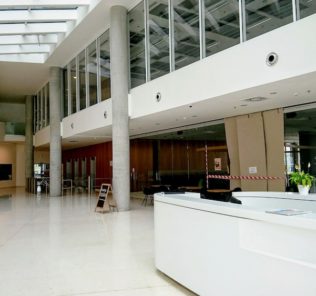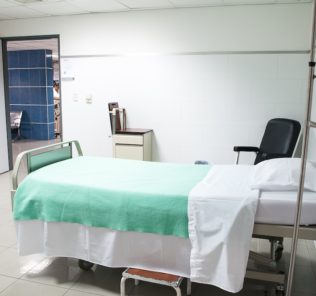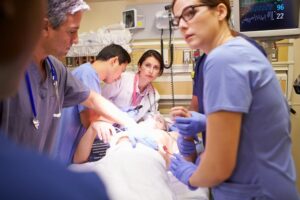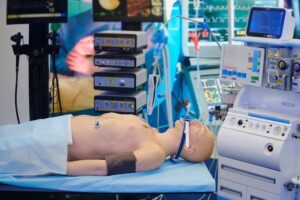New Clinical Simulation Center Updates | November 2021
Healthcare simulation centers are constantly being unveiled and upgraded across the United States and globally. As a dedicated area within a clinical education building, medical center, or training facility which is devoted to healthcare simulation, these spaces have become integral to a learner’s medical education. From design and operations to groundbreaking construction, several clinical simulation centers have recently announced updates. This HealthySimulation.com article shares these updates and explains why they are relevant to their respective facility’s education and training needs.
PLU’s New Clinical Simulation Center Uses 21st Century Tools to Teach Next-Gen Nursing
There are two simulation suites inside Pacific Lutheran University’s School of Nursing’s Clinical Learning and Simulation Center. Located on the corner of Garfield Street and Pacific Avenue in the building that formerly housed the PLU bookstore, the 16,000-square-foot center helps PLU respond to a critical public need, as Washington state is facing a drastic shortage of nurses, according to the school. Funded by individual donors, foundations and community partners, the center doubles the space available to nursing students, preparing them for their careers in a wholly modern way. In addition to the suites, the bright, spacious facility contains a student lounge, a 96-seat classroom, and another 48-student room with four screens, a video conference camera, and a projector to accommodate hybrid learning.
Sponsored Content:
The university shares that the Center’s Clinical Learning Lab is set up to mimic a contemporary hospital environment. In the medication room, students can practice dispensing medications according to patient records. In the lab, lifelike manikins can be set up in 16 hospital-like beds with functional headboards. A whiteboard near each patient provides an opportunity to provide information and a plan of care for each patient.
Southern State Community College Celebrates Ribbon Cutting of New Health Science Center
According to the Highland County Press, Southern State Community College in Hillsboro celebrated the new state-of-the-art Health Science Center with a ribbon cutting with the Highland County Chamber of Commerce, along with learners, employees, elected officials and members of the community, on Nov. 1, 2021. The new Health Science Center will better prepare nursing and medical assisting learners for the healthcare field. The center includes a full-scale simulation lab mirroring modern hospital and health facilities, mid-level skill labs and contemporary lecture spaces.
“Southern State’s nursing and allied health programs have long been preparing health care professions for our five counties and beyond,” Dr. Kevin Boys, Southern State president, said in the report. “We’re excited to see this realistic medical environment featuring state-of-the-art classrooms, simulation labs and medical office space for our students to prepare for their profession.”
Sponsored Content:
Univ. of Saint Joseph Nursing Students Get Real-World Experience in New Program
According to WFSB, the University of Saint Joseph in West Hartford’s new Nursing Education and Simulation Center is providing learners with real-world experience. The new lab, funded by donors, features an expanded space with new beds and equipment. Learners can practice simulations in the lab and then use those skills in all sorts of hospital settings. This advanced technology is helping prepare the next generation of nurses.
“By being prepared, nurses respond. And they take care of the patients the way they need to be taken care of,” Yvonne Joy, director of the Graduate Nursing Program at the University of Saint Joseph, told reporter Ayah Galal.
UMSL Hopes High-Tech Simulation Manikins Will Mean More Nursing Grads
According to NPR, the University of Missouri–St. Louis is betting that a new high-tech training lab for future nurses will help meet the state’s demand for more health care workers. The $7 million projects expands the school’s simulation center, where nursing students use high-tech robotic manikins and computers to learn skills and prepare for human patients. One-fourth of the cost of the project, which more than doubles the number of current clinical simulation rooms and updated learning manikins, came from the state’s MoExcels workforce development program.
“The gold standard for nursing education is the combination of physical and simulation education,” said Annie Vandermause, the school’s dean of nursing, according to the report. “It offers students time to stop and think and critique and prepare and really explore all of the facets of the situation that they can’t necessarily do in an in-person setting.”
UAMS Centers for Simulation Education Takes to Twitter to Discuss Maternal Health
Staff in the University of Arkansas for Medical Sciences (UAMS) Centers for Simulation Education spent Healthcare Simulation Week 2021 highlighting Arkansas’ problematic maternal and fetal mortality rates while sharing UAMS’s efforts to bring that number down. To simultaneously showcase UAMS’ efforts and focus attention on a serious issue in Arkansas, Karen J. Dickinson, M.D., assistant professor of surgery and director of Interprofessional Education Simulation and Clinical Skills Training, came up with a fun plan of social media posts centered on a theme of maternal health. Several tweets from the UAMS Centers for Simulation Education account (@UAMSSIMCENTER) were shared on the Healthcare Simulation Week 2021 Twitter page, which is in association with the Society for Simulation in Healthcare.
According to the article, the lighthearted UAMS tweets told the story of a couple expecting a child as the narrative developed over the course of the week and were illustrated by photos of manikins in the Simulation Center. Alongside this, the tweets highlighted the high-quality maternal mortality-focused simulations conducted at UAMS, including those led by Faiza Khan M.D., associate professor of anesthesiology, and Luann Racher M.D., assistant professor of obstetrics and gynecology.
The Pandemic Changed How Nursing Schools Use Simulation
According to The Lund Report, the Oregon State Board of Nursing issued a temporary waiver allowing nursing programs to substitute more of students’ clinical experience with simulations early in the pandemic. These created scenarios that can include paid actors or specially outfitted manikins that require students to apply key nursing concepts while being observed remotely by instructors. This article shares how healthcare simulation has helped clinical education training continue despite COVID-19 restrictions, specifically across the state of Oregon.
More About Clinical Simulation Centers
Building a simulation center involves a huge amount of planning. All the stakeholders come together and have input into the construction. The technical logistics and equipment are complex. Some simulation centers have simulation laboratories that exactly mimic an operating room, a delivery room, an emergency department, a medical-surgical floor room, an ICU room etc. Experts from medical specialties and educators need to have input into the planning phase of the construction. Once the construction is complete, funds will be needed for ongoing maintenance, repair, and replacement of equipment as it ages.
In many medical simulation training centers, the observation room serves as the debriefing room. In addition, there is usually a separate control room where the simulation technician sits. This is the person dubbed a Simulation Technology Specialist who remotely controls the manikin, such as the Laerdal SimMan3G, and who is responsible for setting up all the equipment and applying any special effects medical makeup called Moulage. In addition, a clinical educator will be present in the control room. The educator, who often speaks the voice of the manikin controls the physiological and spoken responses of the manikin usually in response to the interventions of the learners within the sim lab. The above setup would be typical for a small simulation center.
Now imagine a large-scale healthcare simulation center with multiple sim labs, control rooms, and debriefing. Add in patient examination rooms with standardized patients, rooms full of task trainers, banks of computers, and conference facilities, and the simulation center could easily occupy thousands of square feet. These simulation centers cost millions of dollars to build and operate and are only found in large medical centers and universities. Funding for simulation centers comes from donations, grants, and university/medical center funding. Some simulation centers generate funds by renting out their spaces to other institutions or offering courses for which they charge a fee.
Learn More About Clinical Simulation Centers
Lance Baily, BA, EMT-B, is the Founder & CEO of HealthySimulation.com, which he started while serving as the Director of the Nevada System of Higher Education’s Clinical Simulation Center of Las Vegas back in 2010. Lance is also the Founder and acting Advisor to the Board of SimGHOSTS.org, the world’s only non-profit organization dedicated to supporting professionals operating healthcare simulation technologies. His co-edited Book: “Comprehensive Healthcare Simulation: Operations, Technology, and Innovative Practice” is cited as a key source for professional certification in the industry. Lance’s background also includes serving as a Simulation Technology Specialist for the LA Community College District, EMS fire fighting, Hollywood movie production, rescue diving, and global travel. He and his wife Abigail Baily, PhD live in Las Vegas, Nevada with their two amazing daughters.
Sponsored Content:


















